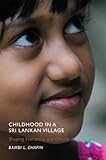Childhood in a Sri Lankan Village : Shaping Hierarchy and Desire / Bambi L. Chapin.
Material type: TextSeries: Rutgers Series in Childhood StudiesPublisher: New Brunswick, NJ : Rutgers University Press, [2014]Copyright date: ©2014Description: 1 online resource (230 p.) : 3 tablesContent type:
TextSeries: Rutgers Series in Childhood StudiesPublisher: New Brunswick, NJ : Rutgers University Press, [2014]Copyright date: ©2014Description: 1 online resource (230 p.) : 3 tablesContent type: - 9780813561660
- 9780813561677
- 305.23095493 23
- HQ792.S72 C53 2014
- online - DeGruyter
- Issued also in print.
| Item type | Current library | Call number | URL | Status | Notes | Barcode | |
|---|---|---|---|---|---|---|---|
 eBook
eBook
|
Biblioteca "Angelicum" Pont. Univ. S.Tommaso d'Aquino Nuvola online | online - DeGruyter (Browse shelf(Opens below)) | Online access | Not for loan (Accesso limitato) | Accesso per gli utenti autorizzati / Access for authorized users | (dgr)9780813561677 |
Browsing Biblioteca "Angelicum" Pont. Univ. S.Tommaso d'Aquino shelves, Shelving location: Nuvola online Close shelf browser (Hides shelf browser)

|

|

|

|

|

|

|
||
| online - DeGruyter Broadcasting Birth Control : Mass Media and Family Planning / | online - DeGruyter Courting Justice : Ten New Jersey Cases That Shook the Nation / | online - DeGruyter Hidden Genocides : Power, Knowledge, Memory / | online - DeGruyter Childhood in a Sri Lankan Village : Shaping Hierarchy and Desire / | online - DeGruyter When Diversity Drops : Race, Religion, and Affirmative Action in Higher Education / | online - DeGruyter The Glass Slipper : Women and Love Stories / | online - DeGruyter The Phantom Holocaust : Soviet Cinema and Jewish Catastrophe / |
Frontmatter -- Contents -- Acknowledgments -- Note on Translation and Transliteration -- 1. Introduction -- 2. Sri Lanka: Setting the Ethnographic Context -- 3. Socializing Desire: Demanding Toddlers and Self-Restrained Children -- 4. Shaping Attachments: Learning Hierarchy at Home -- 5. Making Sense of Envy: Desires and Relationships in Conflict -- 6. Engaging with Hierarchy outside the Home: Education and Efforts at Change -- 7. Culturing People -- Notes -- References -- Index -- About the Author
restricted access online access with authorization star
http://purl.org/coar/access_right/c_16ec
Like toddlers all over the world, Sri Lankan children go through a period that in the U.S. is referred to as the "terrible twos." Yet once they reach elementary school age, they appear uncannily passive, compliant, and undemanding compared to their Western counterparts. Clearly, these children have undergone some process of socialization, but what? Over ten years ago, anthropologist Bambi Chapin traveled to a rural Sri Lankan village to begin answering this question, getting to know the toddlers in the village, then returning to track their development over the course of the following decade. Childhood in a Sri Lankan Village offers an intimate look at how these children, raised on the tenets of Buddhism, are trained to set aside selfish desires for the good of their families and the community. Chapin reveals how this cultural conditioning is carried out through small everyday practices, including eating and sleeping arrangements, yet she also explores how the village's attitudes and customs continue to evolve with each new generation. Combining penetrating psychological insights with a rigorous observation of larger social structures, Chapin enables us to see the world through the eyes of Sri Lankan children searching for a place within their families and communities. Childhood in a Sri Lankan Village offers a fresh, global perspective on child development and the transmission of culture.
Issued also in print.
Mode of access: Internet via World Wide Web.
In English.
Description based on online resource; title from PDF title page (publisher's Web site, viewed 30. Aug 2021)


